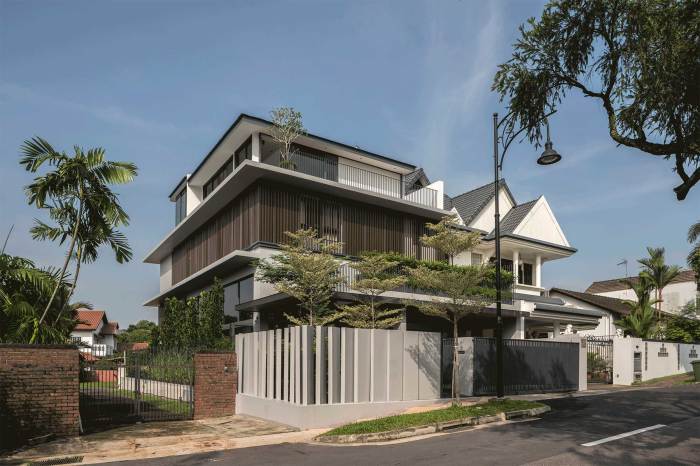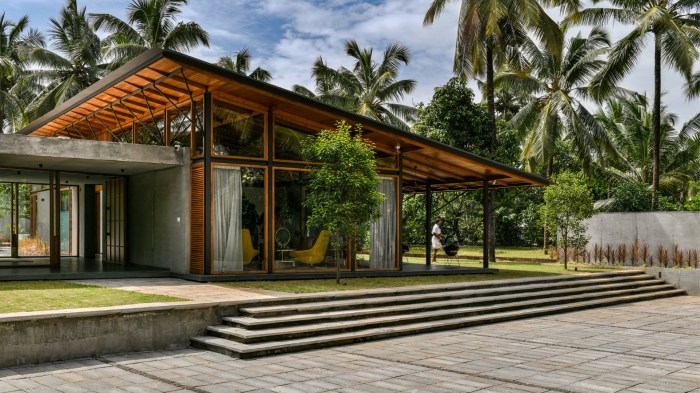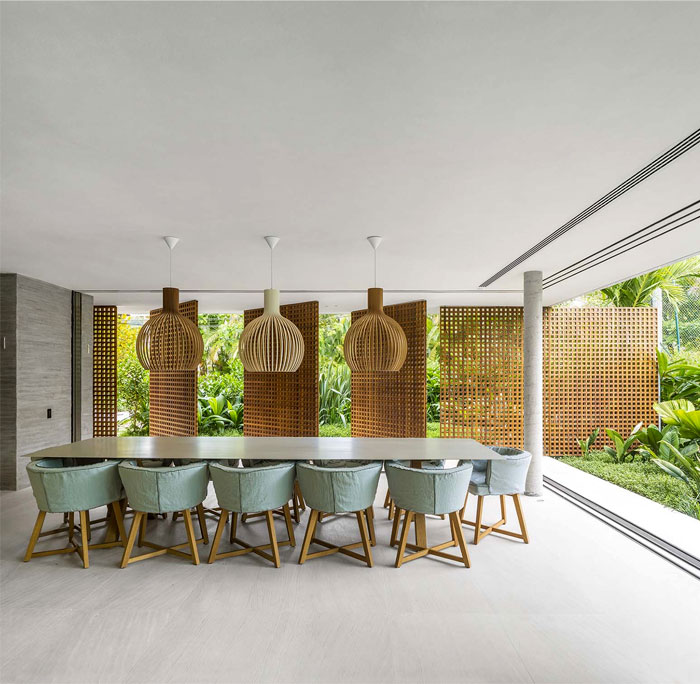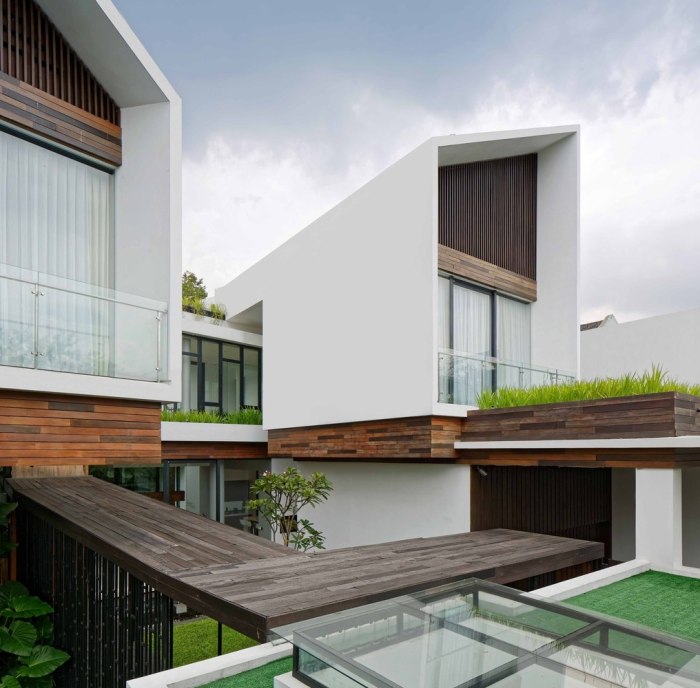Tropical minimalism for hot climates represents a fascinating intersection of design philosophy and environmental adaptation. It transcends mere aesthetic preference, becoming a practical response to the challenges posed by intense heat and humidity. This approach prioritizes functionality and natural materials, creating spaces that are not only visually appealing but also thermally comfortable and sustainable. By understanding the principles of tropical minimalism, we can design homes that harmonize with their environment, promoting well-being and minimizing environmental impact.
This exploration delves into the core principles of this design style, examining how it differs from other minimalist approaches and how it leverages natural elements to mitigate the effects of a hot climate. We will investigate material choices, color palettes, space planning, lighting and ventilation strategies, and landscaping techniques, all aimed at creating a cool, comfortable, and visually stunning living environment.
The scientific basis behind these design choices, focusing on thermal comfort and energy efficiency, will be highlighted throughout.
Defining Tropical Minimalism for Hot Climates
Tropical minimalism, unlike its temperate counterparts, prioritizes functionality and climate responsiveness above all else. It embraces simplicity but with a focus on maximizing natural ventilation, light, and shade to mitigate the intense heat and humidity prevalent in tropical regions. This contrasts with other minimalist styles which often prioritize clean lines and a stark aesthetic, sometimes at the expense of environmental considerations.
Tropical minimalism, instead, integrates seamlessly with its surroundings, creating spaces that are both visually appealing and environmentally sustainable.
Core Principles of Tropical Minimalism
Tropical minimalist design centers around a few key principles. First, it emphasizes open floor plans to encourage airflow, minimizing the need for energy-intensive air conditioning. Second, it utilizes natural materials with high thermal mass, which absorb and release heat slowly, moderating temperature fluctuations throughout the day. Third, it strategically incorporates shading devices, such as overhanging eaves, louvers, and strategically planted vegetation, to reduce solar heat gain.
Finally, it prioritizes natural light, maximizing daylight penetration while minimizing direct sunlight exposure. These principles directly address the challenges posed by hot and humid climates, creating comfortable and energy-efficient living spaces.
Material Selection in Tropical Minimalism
The materials employed in tropical minimalist architecture are crucial for its success. Locally sourced, sustainable materials are favored to minimize environmental impact and reduce transportation costs. Common choices include bamboo, which is lightweight, readily available in many tropical regions, and highly renewable; sustainably harvested timber, offering strength and natural insulation; and natural stone, such as limestone or laterite, known for their high thermal mass and ability to regulate indoor temperatures.
Rammed earth, a traditional building technique, is also experiencing a resurgence due to its excellent thermal properties and low environmental impact. These materials not only contribute to the aesthetic but also enhance the building’s performance in hot climates.
Comparative Analysis of Architectural Styles
The following table compares tropical minimalism with other architectural styles suitable for hot climates, highlighting their distinct approaches to material selection, climate responsiveness, and key features:
| Style | Material | Climate Suitability | Key Features |
|---|---|---|---|
| Tropical Minimalism | Bamboo, timber, natural stone, rammed earth | Excellent (high heat & humidity) | Open plan, natural ventilation, high thermal mass materials, shading devices |
| Mediterranean | Stucco, terracotta tiles, stone | Good (hot, dry summers) | Thick walls, whitewashed surfaces, courtyards, shaded outdoor spaces |
| Vernacular (varies regionally) | Locally sourced materials (e.g., thatch, mud brick) | Good (adapts to specific regional climates) | Passive design strategies tailored to local climate conditions |
Color Palettes and Material Selection

Tropical minimalist design for hot climates prioritizes both aesthetic appeal and thermal comfort. Careful consideration of color palettes and material selection is crucial in achieving this balance, creating spaces that are visually calming and physically cool. The interplay of light reflection, heat absorption, and the inherent properties of materials significantly impacts the overall ambiance and livability of a home in warm weather.Color palettes in tropical minimalist design often leverage the natural environment as inspiration.
These palettes are carefully chosen to maximize light reflection, minimizing heat absorption, and creating a sense of spaciousness. The use of natural materials further enhances this effect, creating a symbiotic relationship between design and environmental response.
Light-Colored Paints and Heat Reflection
Light-colored paints play a vital role in maintaining a cool interior temperature. Their high albedo – the ratio of reflected to incident light – means they reflect a significant portion of the sun’s radiant energy. Darker colors, conversely, absorb more heat, leading to increased indoor temperatures. For instance, a white or light-grey wall will reflect up to 80% of sunlight, while a dark brown or black wall might only reflect 10-20%, leading to a considerable difference in room temperature, especially under direct sunlight.
The difference can be measured in several degrees Celsius. This principle is well-established in architectural physics and is widely applied in hot and arid climates to reduce energy consumption from air conditioning.
Natural Materials and Thermal Regulation
The incorporation of natural materials such as bamboo, rattan, and sustainably sourced wood offers both aesthetic and functional benefits. These materials possess inherent thermal properties that contribute to a cooler interior environment. Bamboo, for example, is known for its breathability, allowing for better air circulation and reducing the buildup of heat. Rattan, with its open weave structure, also promotes air flow.
Wood, particularly lighter-colored woods, reflects sunlight and absorbs less heat compared to other materials like concrete or metal. These natural materials also contribute to a sense of tranquility and connection with the surrounding environment, enhancing the overall tropical minimalist aesthetic. The thermal mass of these materials also helps to moderate temperature fluctuations throughout the day.
Sample Tropical Minimalist Bedroom Color Palette
A soothing and thermally efficient color palette for a tropical minimalist bedroom could include the following:
| Color Name | Hex Code | Description |
|---|---|---|
| Seashell White | #F8F8FF | A soft, airy white that reflects maximum light. |
| Celadon Green | #A7D1AB | A calming, muted green reminiscent of tropical foliage. |
| Driftwood Grey | #B2BEB5 | A neutral grey that complements the other colors, mimicking the color of bleached wood. |
| Ocean Aqua | #79CBCB | A soft, cool blue that evokes a sense of calm and tranquility. |
This palette utilizes light and airy shades, promoting a feeling of spaciousness and coolness, while the muted green and blue tones draw inspiration from the tropical landscape, creating a harmonious and relaxing atmosphere. The use of these colors in conjunction with natural materials like bamboo flooring and rattan furniture would further enhance the cooling effect and contribute to the overall tropical minimalist aesthetic.
Space Planning and Functionality

Tropical minimalist design prioritizes functionality and comfort within the constraints of hot and humid climates. Effective space planning is crucial for maximizing natural resources while maintaining a sense of openness and ease. This involves strategically leveraging natural light and airflow to mitigate the effects of heat and humidity, creating a naturally cooled and well-ventilated living space. Careful consideration of furniture selection and arrangement is also paramount to ensure efficient use of space and to enhance the overall aesthetic.
Maximizing Airflow and Natural Light
The physics of heat transfer are fundamental to tropical minimalist design. Heat, primarily from solar radiation and ambient temperatures, needs to be dissipated efficiently. Maximizing natural light and airflow directly addresses this. Large windows, strategically positioned to catch prevailing breezes, allow for cross-ventilation, creating a natural cooling effect. High ceilings further enhance this effect by allowing hot air to rise and escape, reducing the need for energy-intensive air conditioning.
Light-colored, highly reflective surfaces, both internally and externally, minimize heat absorption, keeping the interior cooler. The design should incorporate elements that strategically channel and distribute these natural resources, creating a comfortable microclimate within the home. For instance, strategically placed louvers or jalousies allow for adjustable light and ventilation control, preventing direct sunlight while permitting airflow.
Space-Saving Furniture and Storage Solutions
In smaller homes common in hotter climates, space-saving furniture is essential. Multifunctional pieces, such as sofa beds that convert into sleeping spaces or ottomans with built-in storage, are ideal. Wall-mounted shelves and foldable tables maximize vertical space, minimizing floor clutter. Modular furniture, easily reconfigured to suit different needs, offers flexibility and adaptability. Built-in storage solutions, such as closets and cupboards, seamlessly integrate with the architecture, eliminating the need for bulky standalone units.
Lightweight materials such as bamboo and rattan are preferred for their breathability and ease of movement, further enhancing the sense of spaciousness. For example, a cleverly designed Murphy bed can disappear into a wall, transforming a living room into a bedroom in seconds.
Integration of Indoor-Outdoor Living Spaces
Blurring the boundaries between indoor and outdoor spaces is a defining characteristic of tropical minimalist design. Verandas, patios, and open-air courtyards extend the living area, creating a seamless transition between the interior and the exterior environment. This not only increases the overall usable space but also promotes natural ventilation and cooling. The use of permeable materials, such as screens or latticework, allows for visual connectivity while providing privacy and shade.
Strategically placed plants and water features further enhance the cooling effect and create a calming, tranquil atmosphere. This design strategy leverages the natural beauty of the surrounding environment, enhancing the sense of spaciousness and connection with nature. For example, a large sliding glass door can seamlessly connect a living room to a shaded patio, effectively doubling the living area.
Essential Furniture for a Tropical Minimalist Living Room
The selection of furniture for a tropical minimalist living room emphasizes functionality and simplicity. The goal is to create a space that is both aesthetically pleasing and conducive to relaxation and comfort. The materials used should be durable, lightweight, and ideally sourced sustainably.
- Modular Sofa: A modular sofa offers flexibility in arrangement and can be easily reconfigured to suit different needs. Materials like rattan or sustainably sourced teak offer both durability and breathability.
- Lightweight Coffee Table: A simple coffee table made from bamboo or recycled wood provides a surface for drinks and other items. Its lightness allows for easy movement and rearrangement.
- Wall-Mounted Shelves: Wall-mounted shelves maximize vertical space and provide storage for books, decorative items, or other essentials. They contribute to a clean, uncluttered look.
- Rattan Armchairs: Lightweight and breathable rattan armchairs offer comfortable seating. Their natural texture adds to the overall tropical aesthetic.
- Floor Lamp: A simple floor lamp provides ambient lighting, enhancing the atmosphere and reducing the need for overhead lighting during the day.
Lighting and Ventilation Strategies

Harnessing natural forces is paramount in tropical minimalist design, mitigating the need for energy-intensive cooling systems. Effective ventilation and strategically implemented lighting significantly impact thermal comfort and energy efficiency, creating a sustainable and pleasant living environment. This section details how these strategies contribute to a healthier and more comfortable home in hot climates.
Natural ventilation, the process of using natural airflow to cool a building, plays a crucial role in thermal comfort in tropical regions. The principle is based on the physics of convection: warm air rises, creating a pressure difference that draws in cooler air from outside. This natural airflow reduces the reliance on air conditioning, lowering energy consumption and minimizing environmental impact.
Studies have shown that well-ventilated buildings can experience a significant reduction in indoor temperatures, leading to improved occupant well-being and reduced energy costs. For example, a study conducted by the University of California, Berkeley, demonstrated a 10-15% reduction in energy consumption in buildings with optimized natural ventilation systems compared to those relying solely on mechanical cooling.
Window Types and Airflow Optimization
Window design is crucial for maximizing natural ventilation and daylight. Different window types offer varying levels of airflow and light penetration. The selection should consider factors such as prevailing wind direction, solar orientation, and privacy requirements. High-performance windows with low-E coatings can reduce solar heat gain while maintaining transparency. Strategically placing operable windows, such as casement or awning windows, on opposite sides of a room facilitates the stack effect, drawing cool air in from one side and expelling warm air from the other.
In contrast, fixed windows, while providing natural light, contribute less to ventilation. Consider incorporating louvered windows for enhanced control over airflow and sunlight penetration.
Strategic Fan Placement and Cooling Enhancement
Ceiling fans and strategically placed portable fans can significantly enhance the effectiveness of natural ventilation. Ceiling fans create air circulation, drawing cooler air upwards and distributing it more evenly throughout the room. This effect is particularly noticeable when coupled with operable windows. Portable fans can be strategically positioned to direct airflow towards occupants, creating a localized cooling effect. The use of fans reduces the perceived air temperature, making the environment feel cooler even without a significant drop in actual temperature.
Studies have shown that even a gentle breeze from a fan can improve thermal comfort, allowing for a higher acceptable indoor temperature.
Kitchen Lighting Design: Balancing Natural and Artificial Light
A well-designed kitchen lighting scheme in a tropical minimalist home balances natural light with artificial sources to create a functional and aesthetically pleasing space. Maximizing natural light during the day reduces the need for artificial lighting, saving energy and promoting a connection with the outdoors. Large windows and skylights, when appropriately shaded to prevent excessive heat gain, are ideal for this purpose.
Artificial lighting should complement natural light, providing sufficient illumination for tasks such as food preparation and cleaning. Consider using energy-efficient LED lights with adjustable brightness and color temperature to create a versatile and adaptable lighting environment. Recessed lighting, under-cabinet lighting, and pendant lights can be strategically placed to highlight specific areas and create a layered lighting effect.
For example, using warm-toned LED lights in the dining area and cool-toned lights for task-oriented areas can enhance the ambiance and functionality of the space.
Landscaping and Exterior Design
Landscaping plays a crucial role in mitigating the effects of intense tropical heat while simultaneously enhancing the aesthetic appeal of a minimalist home. Strategic plant selection, shading techniques, and material choices can significantly reduce energy consumption and create a comfortable, visually stunning outdoor environment. This section details the principles and practices of effective landscaping for tropical minimalist homes.The primary function of landscaping in hot climates is to moderate temperature fluctuations and reduce solar heat gain.
This is achieved through a combination of shading, evapotranspiration (the process where plants release water vapor), and the albedo effect (the reflectivity of surfaces). By carefully choosing plant species and strategically positioning them, one can create a microclimate that is significantly cooler than the surrounding area.
Drought-Resistant Plants for Hot Climates
Many plants thrive in hot, dry conditions and require minimal watering once established. Selecting these drought-tolerant species reduces water consumption and maintenance demands, aligning with the principles of sustainable design. Examples include: Cordyline fruticosa (Ti plant), known for its vibrant foliage and tolerance to drought; Pandanus species (screw pines), offering architectural interest and requiring minimal upkeep; and various succulents such as Agave and Aloe, which store water in their leaves and require infrequent watering.
These plants, chosen for their resilience and visual appeal, contribute to a low-maintenance yet visually rich landscape.
Shaded Areas and Pergolas in Outdoor Spaces
The creation of shaded areas is paramount in mitigating the harsh effects of tropical sun. Pergolas, constructed from durable, locally sourced materials such as treated timber or sustainably harvested bamboo, provide a shaded framework for seating areas and walkways. These structures not only reduce direct sunlight but also create a sense of enclosure and intimacy, enhancing the overall ambiance of the outdoor space.
Strategically placed shade sails or retractable awnings offer additional flexibility, allowing for adjustable shading levels throughout the day. The integration of these elements provides respite from the heat and encourages outdoor living.
Tropical Minimalist Garden Design
Imagine a garden bathed in dappled sunlight, where the sleek lines of a minimalist home are mirrored in the carefully curated landscape. The garden is predominantly composed of drought-tolerant plants, their colors echoing the muted palette of the house. A central pathway, paved with smooth, light-colored stones, winds through the space, leading to a shaded seating area nestled beneath a pergola crafted from dark stained bamboo. Tall Cordyline fruticosa plants, with their deep burgundy leaves, stand sentinel at either end of the pathway, providing a vertical accent. Clusters of Pandanus plants offer textural contrast with their spiky leaves, while strategically placed succulents add pops of color and form. The overall effect is one of serene simplicity, a harmonious blend of natural elements and architectural design.
A small, reflecting pool, lined with dark grey volcanic rock, adds a sense of tranquility and helps to cool the microclimate. The plants are spaced to allow for air circulation, minimizing humidity. The minimalist design allows the natural beauty of the selected plants to shine. The overall feel is one of calm sophistication, a haven of peace amidst the tropical heat.
Conclusion

In conclusion, tropical minimalism offers a compelling model for sustainable and comfortable living in hot climates. By embracing natural materials, maximizing airflow and natural light, and thoughtfully integrating indoor and outdoor spaces, we can create homes that are both aesthetically pleasing and environmentally responsible. The key lies in understanding the interplay between design principles and the scientific realities of thermal comfort.
Through careful consideration of material selection, color palettes, and spatial organization, we can harness the power of nature to create havens of coolness and tranquility, even in the most challenging climates. The resulting spaces are not merely houses, but rather, an embodiment of harmonious coexistence between human design and the natural world.
Query Resolution
What are some disadvantages of tropical minimalism?
While offering many benefits, tropical minimalism might require more maintenance for natural materials like bamboo or rattan. The reliance on natural light and ventilation could also limit privacy in some situations. Furthermore, finding specific materials locally might be challenging in certain regions.
How does tropical minimalism differ from other sustainable design styles?
While sharing the sustainability focus of other styles, tropical minimalism specifically addresses the unique challenges of hot and humid climates. It emphasizes natural ventilation and light more explicitly than other sustainable designs which might focus on insulation or energy-efficient appliances as primary strategies.
Can tropical minimalist principles be applied to apartments or smaller spaces?
Absolutely. The principles of maximizing airflow, using light colors, and selecting space-saving furniture are highly adaptable to smaller spaces. Clever storage solutions and multifunctional furniture are key to success in this context.
Are there any specific pest control considerations for tropical minimalist homes?
Yes, using natural materials increases the potential for pest infestation. Regular inspection and proactive pest control measures, including natural repellents, are crucial. Choosing pest-resistant materials when possible is also advisable.